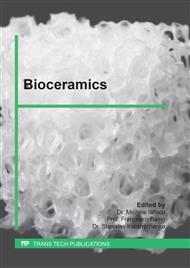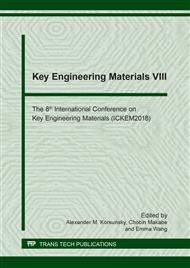[1]
S.V. Dorozhkin, Bioceramics of calcium orthophosphates, Biomaterials, 31 (2010) 1465–1485.
DOI: 10.1016/j.biomaterials.2009.11.050
Google Scholar
[2]
J. Kolmas, S. Krukowski, A. Laskus, M. Jurkitewicz, Synthetic hydroxyapatite in pharmaceutical applications, Ceram. Int., 42 (2016) 2472 -2487.
DOI: 10.1016/j.ceramint.2015.10.048
Google Scholar
[3]
Md. Karimi, S. Hesaraki, M. Alizadeh, A. Kazemzadeh, One-pot and sustainable synthesis of nanocrystalline hydroxyapatite powders using deep eutectic solvents, Mater. Lett., 175 (2016) 89-92.
DOI: 10.1016/j.matlet.2016.04.037
Google Scholar
[4]
K. Venkateswarlu, D. Sreekanth, M. Sandhyarani, V. Muthupandi, A.C. Bose, and N. Rameshbabu, X-ray peak profile analysis of nanostructured hydroxyapatite and fluorapatite, Int. J. Biosci., Biochem. and Bioinform., 2 (2012) 417-421.
DOI: 10.7763/ijbbb.2012.v2.139
Google Scholar
[5]
M. Sadat-Shojai, Md.T. Khorasani, E. Dinpanah-Khoshdargi and A. Jamshidi, Synthesis methods for nanosized hydroxyapatite with diverse structures, Acta Biomater., 9 (2013) 7591- 7621.
DOI: 10.1016/j.actbio.2013.04.012
Google Scholar
[6]
B. Nasiri-Tabrizi, A. Fahami, R. Ebrahimi-Kahrizsangi, Effect of milling parameters on the formation of nanocrystalline hydroxyapatite using different raw materials, Ceram. Int., 39 (2013) 5751- 5763.
DOI: 10.1016/j.ceramint.2012.12.093
Google Scholar
[7]
N.V. Bulina, M.V. Chaikina, Igor Yu. Prosanov, D.V. Dudina, Leonid A. Solovyov, Fast synthesis of La-substituted apatite by the dry mechanochemical method and analysis of its structure, J. Solid State Chem., 252 (2017) 93-99.
DOI: 10.1016/j.jssc.2017.05.008
Google Scholar
[8]
N. Rameshbabu, T.S. Sampath Kumar, R. Murugan and K. Prasad Rao, Mechanochemical synthesis of nanocrystalline fluorinated hydroxyapatite, Int. J. Nanosci., 4 (2005) 643-649.
DOI: 10.1142/s0219581x05003681
Google Scholar
[9]
B. Nasiri-Tabrizi, P. Honarmandi, R. Ebrahimi-Kahrizsangi and P. Honarmandi, Synthesis of nanosize single-crystal hydroxyapatite via mechanochemical method, Mater. Lett., 63 (2009) 543-546.
DOI: 10.1016/j.matlet.2008.11.030
Google Scholar
[10]
R. Ebrahimi-Kahrizsangi, B. Nasiri-Tabrizi, A. Chami, Characterization of single-crystal fluorapatite nanoparticles synthesized via mechanochemical method, Particuology, 9 (2011) 537-544.
DOI: 10.1016/j.partic.2011.07.001
Google Scholar
[11]
C.C. Silva, A.G. Pinheiro, R.S. de Oliveira, J.C. Go´es, N. Aranha, L.R. de Oliveira and A.S.B. Sombra, Properties and in vivo investigation of nanocrystalline hydroxyapatite obtained by mechanical alloying, Mater. Sci. Eng. C, 24 (2004) 549-554.
DOI: 10.1016/j.msec.2004.02.004
Google Scholar
[12]
E.M. Zahrani and M.H. Fathi, The effect of high-energy ball milling parameters on the preparation and characterization of fluorapatite nanocrystalline powder, Ceram. Int., 35 (2009) 2311-2323.
DOI: 10.1016/j.ceramint.2009.01.012
Google Scholar
[13]
M.H. Fathi and E.M. Zahrani, Fabrication and characterization of fluoridated hydroxyapatite nanopowders via mechanical alloying, J. Alloys Compd., 475 (2009) 408-414.
DOI: 10.1016/j.jallcom.2008.07.058
Google Scholar
[14]
A.Patterson, The Scherrer Formula for X-ray particle size determination. Phys. Rev., 56 (1939) 978-982.
DOI: 10.1103/physrev.56.978
Google Scholar
[15]
V.D. Mote, Y. Purushotham and B.N. Dole, Williamson-Hall analysis in estimation of lattice strain in nanometer-sized ZnO particles, J. Theor. Appl. Phys., (2012) 6:6.
DOI: 10.1186/2251-7235-6-6
Google Scholar
[16]
K. Pavankumar, K. Venkateswarlu, N. Rameshbabu and V. Muthupandi, X-ray peak broadening and in-vitro dissolution studies of thermally stabilized nanocrystalline carbonated hydroxyapatite, Key Eng. Mater, 493-494 (2012) 739-745.
DOI: 10.4028/www.scientific.net/kem.493-494.739
Google Scholar
[17]
K. Venkateswarlu, A. ChandraBose and N. Rameshbabu, X-ray peak broadening studies of nanocrystalline hydroxyapatite by Williamson–Hall analysis, Physica B, 405 (2010) 4256-4261.
DOI: 10.1016/j.physb.2010.07.020
Google Scholar
[18]
ASM Hand Book, Powder Metal Technologies and Applications, ASM International, 7(1998).
Google Scholar



